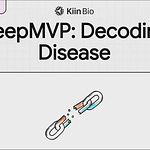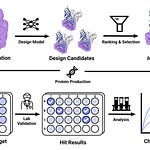What task in your drug discovery work is the most time consuming?
We will send you open-source tools relevant to your pain point.
CRISPR-GPT is an LLM-powered agent system designed to automate and interpret CRISPR gene editing workflows. By combining chain-of-thought reasoning with tool integration and biological context, it transforms complex experimental planning into a reproducible, guided process. The system enables rapid design, validation, and analysis of genome editing experiments across multiple CRISPR modalities.
Key Innovations and Capabilities
1. Prompt-to-Experiment Execution
Plan: Decomposes editing goals into discrete tasks including CRISPR system selection, delivery method ranking, and protocol generation.
Design: Generates guide RNAs, primers, and validation workflows using curated rule sets and external tools.
Analyse: Processes output data through integration with tools such as CRISPResso2 and Primer3, delivering structured reports with efficiency metrics.
Tasks are executed via a multi-agent architecture that simulates expert-level experimental reasoning.
2. Multi-Agent Workflow Coordination
CRISPR-GPT is composed of four core agents:
Planner: Converts prompts into structured workflows.
Executor: Manages state-based task progression.
User Proxy: Handles iterative refinement and dialogue.
Tool Agent: Interfaces with web tools and databases for gRNA search, gene lookup, literature, and sequencing analysis.
Each agent is powered by GPT-4o and fine-tuned on CRISPR-related literature, lab protocols, and community discussions.
3. Tool-Augmented Scientific Reasoning
Integrates with domain-specific platforms including:
CRISPick and CHOPCHOP for gRNA selection
Primer3 for PCR primer design
CRISPResso2 for sequencing data analysis
PubMed and Google Scholar for literature support
Uses retrieval-augmented generation, reasoning templates, and chain-of-thought prompting to guide biological decision-making.
Applications in Genome Editing
gRNA Design: Identifies target exons and generates guide RNAs based on gene structure and species context.
CRISPR Knockouts and Activations: Supports workflows for CRISPR-Cas9, CRISPRa, CRISPRi, base editing, and prime editing.
Experimental Planning: Automates selection of Cas systems, delivery vectors, cell types, and validation assays.
Wet-Lab Assistance: Enables non-experts to design and execute gene editing protocols with minimal prior knowledge.
Performance and Validation
Training and System Capabilities
Fine-tuned on 11 years of CRISPR discussions, PubMed abstracts, and experimental protocols.
Prompt engineering and tool chaining were benchmarked across 22 gene-editing tasks.
Outperforms general-purpose LLMs in accuracy, task decomposition, and sequence design.
Experimental Evaluation
In lab testing by junior researchers:
Four cancer-related genes were successfully knocked out in A549 cells with over 80 percent editing efficiency.
Two immune-regulatory genes were activated in melanoma cells, achieving 90 percent success.
All steps were planned and analyzed by CRISPR-GPT, without expert intervention.
Limitations and Future Work
Current scope: Focused on human and mouse gene editing using short-read assemblies.
Challenges: Performance varies on rare targets, non-model organisms, and pooled screening designs.
Planned expansion: Integration with robotic automation, support for metagenomic inputs, and training with phenotype-linked datasets (e.g., MIC, viability assays).
Why It Matters
CRISPR experimentation remains fragmented and labor-intensive, requiring expert knowledge and multiple tools. CRISPR-GPT unifies planning, design, and analysis in a single framework that can reason, search, and adapt in real time. It enables scalable, reproducible gene editing for therapeutic discovery, functional genomics, and bioengineering, lowering the barrier to entry while improving experimental accuracy and throughput.










